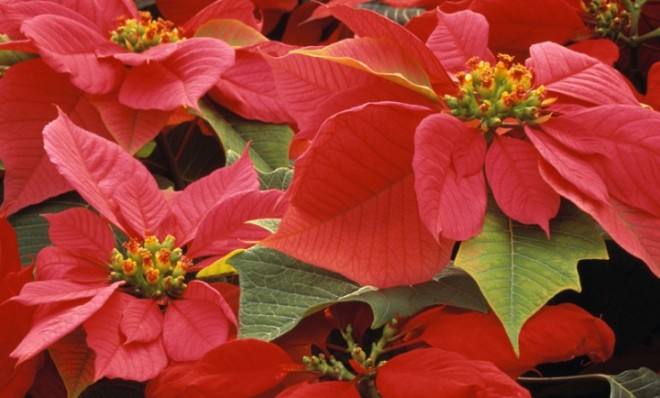Are poinsettias as dangerous as everyone says?
The truth behind the lore surrounding the seasonal plant


Poinsettias are as indispensable to Christmas as evergreen trees and mistletoe. Every year, they come out of the greenhouses and off the store shelves into our homes, and every year, some well-meaning but factually challenged aunt or family friend warns us that we shouldn't have the plants out around the baby or the cat or the dog because they're extremely poisonous. This idea originated in 1919, when a 2-year-old child in Hawaii reportedly ate the leaves of a poinsettia and soon fell ill with diarrhea, vomiting, and delirium, and then died. While never confirmed as a case of poisoning, the story got repeated over and over and eventually the deadly poinsettia entered into modern urban mythology. In reality, while Euphorbia pulcherrima is not something you want to be munching on, it's certainly not a killer. Since fingers were first pointed at it in Hawaii, plenty of research has been done on the poinsettia, and none of it has turned up anything to be alarmed about.
Lab rats
Researchers have dosed animals with poinsettia leaves and flowers and applied the plant's sap to their eyes and skin. They've observed their behavior and cut them open to examine their intestines. In these experiments and others, the ingested poinsettia never led to signs of poisoning (sap on the skin is another story, and we'll get to that in a minute). The highest experimental dose of poinsettia that I was able to find in a study was 25 grams per kilogram of body weight, which led to no toxic effects in lab rats. The researchers who did this study say that, assuming no species variation in reactions, a 50-pound child/dog/enormous cat would need to eat about a pound and quarter of poinsettia leaves to reach that dosage. Different animals do have different levels of tolerance for toxins, though, and scavengers like rats tend to be more tolerant than others. But because we can't directly test poinsettia toxicity in humans in a lab — pesky ethics and all that — we have to rely on the animal model to give us an idea of toxicity. Even if we're only in the ballpark, though, getting anywhere near that experimental dose would still require a person or pet to eat a few hundred poinsettia leaves, which are reportedly incredibly bitter and awful tasting.
The Week
Escape your echo chamber. Get the facts behind the news, plus analysis from multiple perspectives.

Sign up for The Week's Free Newsletters
From our morning news briefing to a weekly Good News Newsletter, get the best of The Week delivered directly to your inbox.
From our morning news briefing to a weekly Good News Newsletter, get the best of The Week delivered directly to your inbox.
Real-world cases
What researchers can also do to study toxicity in humans is look at cases of actual poisonings outside the lab. In 1996, researchers from the Pittsburgh Poison Center and several area universities combed through more than 22,000 poinsettia-exposure cases reported to poison control centers (almost 94 percent of which involved children). They found no fatalities, and in 92.4 percent of the cases, the patients experienced no toxic effect. Most of the rest experienced only minor symptoms. Only one case was reported as having a "major effect," but a closer review of that case led the researchers to think that that was a actually coding error in the records. Long story short: Despite Aunt Edna's protests, the evidence says that poinsettias are so mildly toxic (if at all) that any amount a child or pet could bear to eat should be safe and will only result in minor to moderate symptoms like nausea and stomachache. The plant's latex, though, can also irritate the skin and mucus membranes in both animals and humans, causing rashes and irritation. Unpleasant? Yes. Deadly? No.
Everything else you should know about poinsettias
The poinsettia originates in ancient Mexico, where the Aztecs cultivated it and called it cuitlaxochitl. They used extracts from its leaves to dye cloth, its sap to treat fevers, and the whole plant as a decoration and a symbol of purity in their religious ceremonies. The plant would not grow in their high-altitude capital, Tenochtitlan, so rulers would import them from lower-lying areas. Montezuma is said to have loved the plants so much that he sent caravans out to bring them back to his palace by the thousands. In the 1820s, Joel R. Poinsett was appointed as the first U.S. ambassador to Mexico. In addition to diplomacy, he was interested in botany. Taken with the beauty of the red and green plants he saw, he sent cuttings from some back to his greenhouse at home, and American horticulturalists soon began breeding it and marketing it as a houseplant. In 1836, botanists' magazines and other sources began identifying the plant by the common name poinsettia, a clear nod to the man who introduced it to the U.S. Aside from Poinsett, probably no one did more to popularize the poinsettia in America than the Eckes. In 1900, German immigrant Albert Ecke and his family traveled through the U.S. on their way to open a health spa in Fiji. When they reached Los Angeles, they decided to stop the journey and settle down there. They planted orchards and fields of flowers, including chrysanthemums, gladioli, and poinsettias.The family eventually realized that the poinsettia, which bloomed in early winter near the holidays, could be a major money maker in the off-season. They began to aggressively market the plant as a "Christmas flower." The idea wasn't too far off, since the plant was already a part of Christmas decoration and ritual in its native Mexico, where Spanish-speaking Mexicans knew it as as la flor de la nochebuena, or "the flower of the Holy Night."
A free daily email with the biggest news stories of the day – and the best features from TheWeek.com
More from Mental Floss...
* How poisonous is the lily of the valley?
-
 ‘If regulators nix the rail merger, supply chain inefficiency will persist’
‘If regulators nix the rail merger, supply chain inefficiency will persist’Instant Opinion Opinion, comment and editorials of the day
-
 Trump HHS slashes advised child vaccinations
Trump HHS slashes advised child vaccinationsSpeed Read In a widely condemned move, the CDC will now recommend that children get vaccinated against 11 communicable diseases, not 17
-
 Hegseth moves to demote Sen. Kelly over video
Hegseth moves to demote Sen. Kelly over videospeed read Retired Navy fighter pilot Mark Kelly appeared in a video reminding military service members that they can ‘refuse illegal orders’